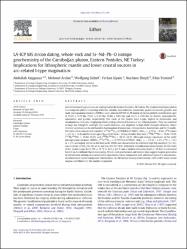| dc.contributor.author | Kaygusuz, Abdullah | |
| dc.contributor.author | Arslan, Mehmet | |
| dc.contributor.author | Sıebel, Wolfgang | |
| dc.contributor.author | Sipahi, Ferkan | |
| dc.contributor.author | İlbeyli, Nurdane | |
| dc.contributor.author | Temizel, İrfan | |
| dc.date.accessioned | 2014-10-09T11:31:40Z | |
| dc.date.available | 2014-10-09T11:31:40Z | |
| dc.date.issued | 2014-02-15 | |
| dc.identifier.uri | https://hdl.handle.net/20.500.12440/642 | |
| dc.description.abstract | Late Cretaceous I-type plutons arewidespread in the Eastern Pontides,NE Turkey. The studied Camiboğazı pluton is a composite pluton consisting of diorite, tonalite, monzodiorite, monzonite, quartz monzonite, granite, and mafic microgranular enclaves (MMEs). Laser ablation ICP-MS U–Pb dating of zircon yielded crystallization ages of 76.21 ± 0.79 Ma, 75.65 ± 0.50 Ma, 75.04 ± 0.83 Ma, and 74.73 ± 0.86 Ma for diorite, monzodiorite, monzonite, and granite, respectively. The rocks of the pluton have I-type, high-K to shoshonitic and metaluminous character, displaying whole-rock geochemical features of arc-related granites. They are enriched in large-ion lithophile and light rare-earth elements, and depleted in high-field-strength elements. Major element variations can be attributed to fractionation of plagioclase, clinopyroxene, hornblende, and Fe–Ti oxides. The rocks show considerable variation in 87Sr/86Sr(i) (0.70498 to 0.70622), ?Nd(i) (-2.79 to-0.36), ?18O values (+6.3 to+11.4) and Ndmodel ages (TDM) (0.81 Ga to 1.26 Ga). Besides, they have (206Pb/204Pb)= 18.44–19.09, (207Pb/204Pb) = 15.64–15.69, and (208Pb/204Pb) = 38.37–38.89. Although isotope signatures of the mafic microgranular enclaves (MMEs) (87Sr/86Sr(i) = 0.70551 to 0.70622; ?Nd(i) = -2.9 to -1.23; ?18O = +8.3 to +9.7) are largely similar to the host rocks, MMEs are characterized by relatively high Mg-numbers (32–36), low contents of SiO2 (52–56 wt.%) and low ASI (0.7–0.9). Estimated crystallization temperatures for the rocks of the pluton range from 735 ± 58 °C to 844 ± 24 °C and a shallow intrusion depth (b10 km) is estimated fromAl-in-hornblende thermobarometry.Whole-rock geochemical and isotopic data suggestmagma generation by dehydrationmelting of an amphibolite-type lower crustal componentwith additional input of a subcontinental lithosphericmantle component. Furthermore, Sr–Nd isotopemixingmodel reveals ~30% to 40% lower crustal magma contribution to the mantle component. | en_US |
| dc.description.sponsorship | Turkish Research Foundation (Grand No.109Y052). | en_US |
| dc.language.iso | eng | en_US |
| dc.publisher | Elsevier B.V. All rights reserved | en_US |
| dc.rights | info:eu-repo/semantics/restrictedAccess | en_US |
| dc.subject | Camiboğazı pluton Eastern Pontides I-type Late Cretaceous Sr–Nd–Pb–O isotope U–Pb zircon dating | en_US |
| dc.title | LA-ICP MS zircon dating, whole-rock and Sr–Nd–Pb–O isotope geochemistry of the Camiboğazı pluton, Eastern Pontides, NE Turkey: Implications for lithospheric mantle and lower crustal sources in arc-related I-type magmatism | en_US |
| dc.type | article | en_US |
| dc.relation.publicationcategory | Makale - Ulusal Hakemli Dergi - Kurum Öğretim Elemanı | en_US |
| dc.department | Fakülteler, Mühendislik ve Doğa Bilimleri Fakültesi, Jeoloji Mühendisliği Bölümü | en_US |
| dc.contributor.institutionauthor | Kaygusuz, Abdullah | |
| dc.contributor.institutionauthor | Sipahi, Ferkan | |


















